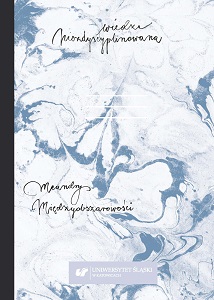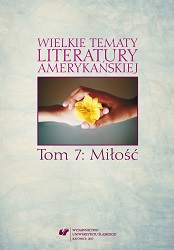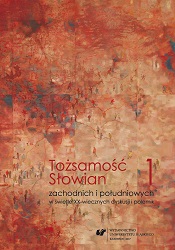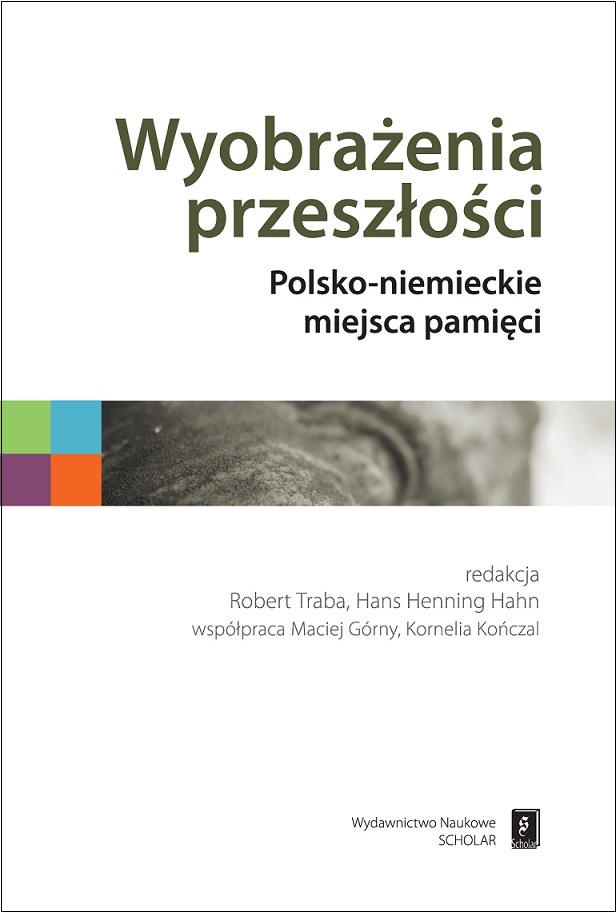
We kindly inform you that, as long as the subject affiliation of our 300.000+ articles is in progress, you might get unsufficient or no results on your third level or second level search. In this case, please broaden your search criteria.




The authoress of this article has attempted to read the play by an Americanplaywright Eugene O’Neill in the light of the concept of love as proposed by Erich Frommin 1956. This German philosopher argued that the only way to escape loneliness, a feelingto which everybody is doomed, is to unite oneself with another person in love.In a popular publication, titled The Art of Loving, Fromm describes various forms of love;Desire Under the Elms – a play written more than three decades before Fromm’s publication– seems to illustrate these philosophical considerations. Such a view on O’Neill’s workallows to notice its human dimension, and perceive its protagonists as an embodimentof the universal human condition.
More...
The article aims at presenting three strategies the heroes of Jewish originapply to mixed marriages. In Tevye the Dairyman, Sholem Aleichem shows how the preceptof preserving ethnic separatism and the necessity of Judaism to survive during thediaspora dictated complete rejection of exogamy and excluded those who violated thisnorm from the Jewish community. For the heroine of Anzia Yezierska’s novel Salome ofthe Tenements, marriage to a rich goy was supposed to be an open sesame to the betterprivileged America; however, it turned out to be a painful object lesson in cultural andlinguistic differences. And finally, the contemporary protagonists of Philip Roth’s novelThe Counterlife struggle with the issue of their own identity – the character of shiksa constitutes a specific catalyst for the questions of the nature of Jewishness in Roth’s book.
More...
This article outlines the concept of brotherly love in Jerome David Salinger’sThe Catcher in the Rye, one of the most censored novels in the United States. Although primarily the book presents such issues as alienation, seclusion, and rebellion against theartificiality of the world of adults, what is particularly worth pointing out is the importanceof the relationship between Holden, the main protagonist, and his younger siblings:his sister Phoebe and his brother Allie. Although love is not explicitly expressed in thenovel, it is apparent in Holden’s attitude to his siblings and in his memories and descriptionsof Phoebe and Allie.
More...
In this article, an attempt has been made to show Anaïs Nin’s understandingof love and the philosophy of “new erotica” and “new woman” resulting from it in thelight of selected works by the writer: The House of Incest, Spy in the House of Love, Seduction of the Minotaur, and Diaries. This philosophy – developed in the diaries and then transposed into fiction presented in the form of continuous novel – refers to the life of Nin and her vision of a “new woman,” in which the writer then attires the heroines of her novelsand makes them wear it as their own. The multifaceted nature of a woman, manifested inher various roles, both creative and destructive, is expressed in her dreams, in her lusts,in a pattern that is unique to every woman. Exploring herself through sexuality becomesa source of knowledge for Nin about herself and about women in general.
More...
This article constitutes a comparative analysis of Louise Erdrich’s Love Medicine and Sandra Cisneros’ Caramelo with regard to the theme of family love used by the authoresses. In both works, the search for love in the family is related to the broader context of reconstructing ethnic community bonds and the analysis of metissage. What also seems important here is the motive of creating the identity in the ethnic and post‑ethnic perspective. Moreover, an attempt to reconstruct ethno‑history from the feminist perspective can serve as a common denominator of Love Medicine and Caramelo.
More...
Love stories often provide the thread for the literary works of American female writers of Indian origin. Also, the topic of food is important in such texts: the representations of food, related rituals (preparation, consumption) play a significant role in the literature of the diasporas, because they are a way of emphasising cultural distinction and building the identity of a specific group (Mannur). The purpose of the article is to discuss the ways of representing love with the use of food‑related motifs in three works by Indo‑Americanfemale writers: a novel by Bharati Mukherjee Jasmine (1989), in Mistress of Spices (1997) by Chitra Banerjee Divakaruni, and in Jhumpa Lahiri’s A Temporary Matter from the collection titled Interpreter of Maladies (1999). Based on the presented analyses, it is possible to conclude that for female writers from the first generation of immigrants, the topic of love is partly intertwined with the confrontation of distinct, diverse cultures. Cuisine‑relatedmotifs in the novels of Mukherjee and Divakaruni highlight culture differences and help explore identity issues. Jhumpa Lahiri is a representative of the second generation of immigrants; her story presents the topic of love told with the help of food‑related elements and disconnected from the ethnic background and shows the universal human experience. Food is a metaphor of love presented as an attitude based on involvement, and does not convey additional meanings.
More...
The purpose of the article is to show how the protagonists of the stories representatives of ethnic minorities, who find it difficult to adapt to living in the United States and often experience nostalgia – subconsciously wish to return to their ancestor’s homeland. Adultery, entering into close, intimate contact with prostitutes of the same descent as their customers, or forbidden love to a person or people who happen to belong to the same ethnic group – all this becomes an expression of a strong need to return home. Searching for fulfilment in extramarital affairs and deep fascination with Polish women of dubious reputation are also presented in the selected stories by Anthony Bukoski and Stuart Dybek, two contemporary American writers of Polish descent.
More...
Drama is not a favourite genre among American critics and it has been so for decades. Misogyny (or what might appear similar to it) has also grown out of fashion, hopefully for good. The combination of the two makes it all the more difficult for an author to “fare well” among the critics. My paper tries to highlight the fact that Sam Shepard, although often perceived as a misogynist for the treatment of his female characters both by his “men” and himself is not (as much) “guilty as charged”. The point I am trying to make is that the playwright did not (always) ignore his female characters and leave them voiceless because it pleased him to do so. He did it because what he understood best about the human condition was male anxiety and neurosis. A Lie of the Mind is his, albeit failed, attempt at understanding the female side and even incorporating it. What the play offers as a conclusion is that love seems to be a mission impossible for the strong and the healthy. It tries to persuade the reader (and this attitude can be found explicit frequently in his plays) that love is a(n) (unnutural) condition, an illness of a sort. Love is a survival mode for the weak. The strong do not need it. On this not very encouraging a note does the play end as well as all Shepard’s further attempts at dealing with women characters in a way different from his usual.
More...
Although the album entitled The Pale Emperor is intended primarily asMarilyn Manson’s commentary on the repayment of broadly understood debts, it can beobserved that some of the lyrics from this album refer to the rockman’s views on love.The purpose of the text is to flesh out of these views from the chosen lyrics and to make anattempt at their interpretation from the perspective of Friedrich Nietzsche’s philosophy,from which the musician draws while building his understanding of the world. An attemptis made to demonstrate that these views make up the image of love, which is a catalystof will to power for Manson.
More...
The article “Identity as a value” discusses the trends of contemporary reflection on identity. It presents some problems of individual and collective identity (cultural, social, national ones). It considers the need for identity in the view of the dynamic developmentof history and culture, identity problems, and the positive and negative influences the concept of identity may be subjected to. The author of the article draws attention to the peculiar nature of the discourses Slavic identity. They combine the identity problems of language and culture, collective memory and ethical entity. Nowadays the dominant tendency is to understand identity as a cultural value. It requires axiological memory and responsible co‑creation of an open model of culture.
More...
A common semantic area of the concepts of stereotype and identity determines their stigmatising property, serving equally individualisation and unification, while they differas far as axiological marking, the object and tools of cognition are concerned. The identity crisis, which was frequently announced at the end of the last century, relates to the crisis of a stereotypical conception of identity as an unchanging picture. Given that identity has a processual character and is shaped by the possessed knowledge, designation of its boundaries, i.e. their ultimate specification signifies stereotypisation by which social and political manipulation becomes possible. Possession of identity does not determine a positive evaluation of a person or of a community, whereas identity stereotypes have a clear evaluation charge. Therefore, the concept of identity, corresponding with subjectivity, integrity and stereotype is rooted in a wider social, cultural, historical and narrative context rather than solely in the moral context. Identity, therefore, is a combination of awareness with behaviour and the ability to express oneself. The subject, as an agent of the correlation of consciousness, of behavior and of expression exists in a frequent conflict with the weakness of the will ofan individual or of the will of the representatives of a community – the authority, whichleads to the phenomenon of self-deception by means of identity stereotypes.
More...
The paper presents selected opinions of the Bulgarian literary scholars on Bulgarian culture in a very specific point of time. The last decade of the 20th century in post-communist countries was a time of an increased interest in a cultural model.Even though the post-transformation period brings new methodologies and with them a new conceptual apparatus, Bulgarian scholars must again face the Revival-related (as well post-revival and pre-modernistic) issues, focused – for obvious reasons – on the concept of the canon and the Us-Them dichotomy. Three texts, about literature, translation and culture, respectively, are analyzed: Нация и литература в точката на “Балкана” (Nation and Literature in the “Balkan”) by Blagovest Zlatanov, Българското възраждане и Европа (Bulgarian National Revival and Europe) by Nikolay Aretov and The Self-Colonization Cultures by Aleksander Kiossev.
More...
The article discusses the constructions and the problems of Bulgarian national and cultural identity based on Ani Ilkov’s poetry written in the 1990s. In the early 1990s, thenew political and social realities forced nations of the former Eastern bloc to (re-)readcultural, literary and historical traditions, including the national topoi, myths and stereotypes.Ilkov redefines the national tradition and cultural heritage, he boldly inquiresabout the problematic Bulgarian identity and reinterprets the historical past.
More...
The paper analyzes the problems of the Croatian national identity in Krleža’s novel Flags/ Zastave (1976), the “dramatic history” of the agony and the final collapse of Austria-Hungary, the Balkan Wars, Wold War I and the newly formed South Slavic state community.Through the political genesis of the basic actant of the novel and his relation to other characters of the novel the national identity genesis will be monitored as well: from romantic Croatianhood, that strongest (non-state) foothold in the Arcadian experience of “our lovely homeland”, then the ecstatic Yugonationalism as a way out of the “large prison of nations” to the “bloody caricature” of the hero’s youthful political dreams in the Kingdom of Serbs, Croats and Slovenes. In the novel, by analogy, mirror images of unresolved national issues in the Socialist Federal Republic of Yugoslavia are noticeable.
More...
In the historical and cultural narrative of the 1950s in Croatia, one of the most important points is the release of the first issue of the “Krugovi” magazine in 1952. The writers that gathered around the newly formed magazine started a period of affirmation of diversity and praise of creative freedom in any possible form. The young generation did not agree with the imposed dogmas and promoted aesthetic clichés, but they did not fight openly.Nevertheless, despite the fact that the magazine was proclaimed apolitical, the authorsfailed to keep a hundred percent of impartiality and they sometimes spoke on issues theyconsidered important, such as the signing of the agreement of Novi Sad in 1954, whichthey considered harmful in reference to the Croatian language.
More...
Linguistically speaking, man is different from all other living beings, and therefore the language at the time of expressiveness is the essence of being. The language as an institution is what created the individual human spirit, as well as the society in which theindividual exists as a zoon politikon. The history of South Slavic linguistic relations can be viewed from the standpoint of Hegel’s dialectical trinity: thesis – antithesis and synthesis. The thesis of the language as the image of the world is in connection with the form of life. Connecting the historical experience of the poetic vision is realized in the works of Croatian writers. The consciousness of the common ethnogenesis, Proto-Slavic and old Slavic paradigms, is present in Croatian literature from Gundulić and Palmotić to Ujević, Simić, Krleža. As a system, Shtokavian has multiple realizations. The Croatian standard, in its own identity and uniqueness, constitutes realization is one of them by accessing the language like a sociolinguistic category, a short history of Croatian-Serbian language relations, reference tothe history, and the present Croatian language refers to Wittgenstein’s thesis according towhich the reflective linguistic representation of the world is in fact reflective of the languageof facts. International acknowledgment Croatian language, from the perspective of Hegel’s dialectic, is the point at which alienated ideas in the spirit of self-consciousness of the people come back again to themselves. It does not represent the ending point. On the contrary, it is the opening of a new perspective on the Croatian language.
More...